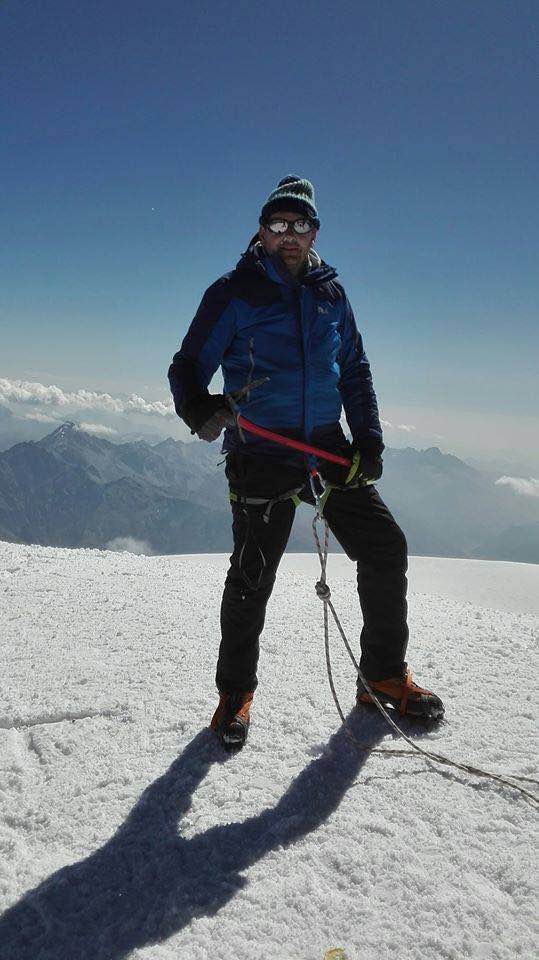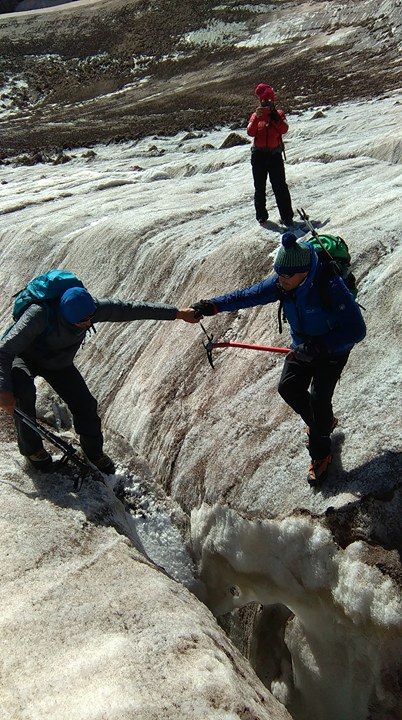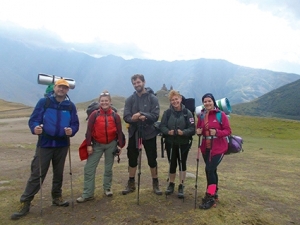Fergal Reaches New Heights in Kazbegi, Just 6 Years after a Major Back Op
In 2001, Irishman Fergal Hingerty was diagnosed with chronic sciatica caused by spinal deterioration from an old back injury. The prognoses left him with a choice: a risky major operation that might leave him in a wheelchair, or spending the rest of his life in a wheelchair. He chose the first option and not only managed to recover from the subsequent 9-hour operation, but went on to find his passion in hiking and mountain climbing. Now, having climbed almost all the highest mountains in the UK, he chose Georgia and Mount Kazbegi as his latest life challenge.
GEORGIA TODAY met back up with Fergal in Tbilisi the day he returned to civilization from the four-day climb. Pink nosed, bleary-eyed and suffering from a ‘mountain cough’, he looked exhausted.
“I should be feeling exhilarated, but I’ve barely slept- I guess it’ll sink in in a day or so,” he says with a smile.
Kazbegi was recently named by Business Insider UK among the ‘Top 10 Places to Do in Your Lifetime’.

Fergal at the summit of Mount Kazbegi
Our first question: Did you make it to the top? A resounding, filled-with-well-deserved-pride: Yes! Though not, he tells us, without difficulty.
“We set off at two o’clock in the morning, pitch black, head-torches on. I got a little dehydrated despite filling myself up with tea. The problem at the hut there (3700m and seven hours’ hike up from the village of Stepantsminda) is a lack of fresh water. Everything has to be boiled and re-boiled, it comes from the glacier so it’s full of sand. That takes time. It wasn’t something I was well enough prepared for,” he admits.
Another issue was pacing. “At one stage, for a few minutes, I couldn’t catch my breath,” he says. “You get into a rhythm. When the guide briefly sped up, that rhythm got broken and I started hyperventilating. But it didn’t last long, a few minutes at most: mind over matter, the way I always do it”.
Another issue, a serious one, was a broken crampon. “Thank God the guide was able to fix it,” Fergal says. “Otherwise I would have had no grip and no more climb- I wouldn’t even have been able to get back down. The 5-strong team I was with would have been let down and so would I.”
Not surprising, considering the ice sheets needing to be crossed. “Even an area that looked easy to cross, sandy, turned out to have a solid sheet of ice beneath,” he says.
But the guide was able to save the day and with bang and twist, all was well- and up the team went in “fine” 40 mile-per-hour winds, temperature minus 20, all the way to the top, zigzagging past crevasses and enduring a horse-ride across a swollen glacial river.
“I was so exhausted and, because of the strong winds, I couldn’t raise the sponsor’s or Ireland flag,” Fergal laments of his moment at the summit. “Plus the fact I’d already lost a glove in the wind on the way up- it was whipped out of my hand when I took it off to take a picture”. As on all his climbs, however, he did have spare gloves.

Kazbegi is the highest mountain (5,047 m) Fergal has climbed to date, and the experience has changed him, he says, joking of the ‘hills’ he climbed before in Wales and Scotland, now seeming nothing in comparison. We ask him what’s next and he tells us some Iranians he met in the hut invited him to climb Iran’s highest- Mount Damavand (5,610m above sea level) but with a stunning hike through sulphur flats beforehand, Damavand being a potentially active volcano.
We asked Fergal how he would rate his experience hiking in Georgia.
“The views were absolutely stunning,” he told us. “There were just two negatives- the sanitation issue at the hut and the rescue team.”
At the 50-person hut, he met climbers from Iran, the UK, Canada, South Africa, Czech Republic, Poland, Slovakia, Ukraine, Israel, France- “all kinds of people from all kinds of places wanting to climb this mountain, but if you don’t have a mountain rescue, then you’re going to have a very serious incident up there”.
Just two days after Fergal got down, reports reached him that a 42-year-old Polish climber died from altitude sickness, allegedly because he failed to alert his team he was suffering. The Ministry of Internal Affairs is looking into the case. “I was shocked when I heard that,” he told us when we contacted him about it. “We passed his group on the way down”.
“There is a permanent rescue team based in Stepantsminda, and the helicopter from Rooms hotel helps out if needed- but to get from the village to the hut is a seven-hour hike. From there to the peak is another seven hours”.
“There’s a tragic picture up there- people dying or going missing, you hear the stories,” Fergal tells us. “But even in Ireland, mountain rescue is depressingly underfunded”. Slipping and breaking a leg, disappearing down impenetrable crevasses, getting lost, dying of exposure or altitude sickness- these are risks familiar to any experienced mountain climber, but ones which can be mitigated by a permanent on-location rescue team.
Fergal told us of a two-man volunteer Polish rescue team based at the Meteora Bethlemi Hut shelter within the frames of the ‘Safe Kazbek’ project through which the Medyk Rescue Team Foundation maintains the duty of Polish lifeguards. All rescuers participate as part of a social project and the equipment and maintenance of the base (a tent!) and on-call service is possible thanks to sponsors and donors.
“Everyone is an expert in their field, ranging from medical rescue, missing search, high altitude rescue to mountain climbing. Together we create an excellent team ready to act in any, even the most demanding conditions,” the Medyk website claims. GEORGIA TODAY will be interviewing them this week.
The Meteora Bethlemi Hut, we are informed, lacks toilets and showers, and to answer the ‘call of nature,’ people have to head outside to the nearby ‘rubbish dump’.
The idea came up in our discussion with Fergal that the local authorities could charge visitors some 10 GEL, half of which would go to sewage and hut maintenance and half towards mountain rescue. It currently costs 20 GEL to stay in the hut and 5 GEL to camp outside. In February, we reported on an initiative by entrepreneur David Chichinadze, who has vast experience working with the Swiss Development Agency managing disaster risk reduction and several construction projects in difficult-to-reach locations, to build the $400,000 ‘Altihut’ complex. Altihut will offer a café/restaurant, accommodation for up to 30 people, toilets, showers, washing facilities, a shop, rental equipment, mountain guides, and will accommodate mountain rescue services. “The main target group will be hikers, day trippers visiting the glacier, mountain bikers, ski tourers in winter and, of course, climbers,” Chichinadze told us. It is expected to be ready to host its first tourists in summer 2018.
Until then, those wishing to climb Kazbegi will just have to hold their noses and be prepared: the views alone make such issues seem small. And as is the case with any extreme tourism, do your research before you go.
“It’s tough going up there,” Fergal says. “And now I have great admiration for those lads that climb Everest, or indeed any remote mountain over 7000 meters; three to four weeks on the go, boiling water…going to toilet outside in minus 20. I’ve gone up a level with Kazbegi. It was nearly beyond me but my extraordinary will to never, ever give up pushed me to it. 50% of climbers don’t get to the top; the wind’s often too strong and the storms can be too dangerous to even attempt to climb in, but the view over the glacier is just something else. To be honest, I would have been happy even with the view from the little chapel up there (at 4000m).. But, no, nothing was going to stop me from getting to the top, even if I’d had to do it on my hands and knees. It’s that will to win. And when you look back up at that mountain from Kazbegi. Wow. Yeah. It’s a big achievement”.
By Katie Ruth Davies
Main photo: Fergal Hingerty on Mount Kazbegi with fellow climbers Anya Bào, Michał Twardowski and Aneta Flis












